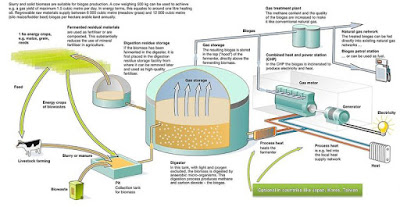Biogas production from Vietnamese animal manure, plant residues and organic waste: Influence of biomass composition on methane yield
Biogas
typically refers to a mixture of different gases produced by the breakdown of
organic matter in the absence of oxygen. Biogas can be produced from raw
materials such as agricultural waste, manure, municipal waste, plant material,
sewage, green waste or food waste. Biogas is a renewable energy source.
Biogas
can be produced by anaerobic digestion with anaerobic organisms, which digest
material inside a closed system, or fermentation of biodegradable materials.
Biogas
is primarily methane (CH4) and carbon dioxide (CO2) and may have small amounts
of hydrogen sulfide (H2S), moisture and siloxanes. The gases methane, hydrogen,
and carbon monoxide (CO) can be combusted or oxidized with oxygen. This energy
release allows biogas to be used as a fuel; it can be used for any heating
purpose, such as cooking. It can also be used in a gas engine to convert the
energy in the gas into electricity and heat.
Biogas
can be compressed, the same way natural gas is compressed to CNG, and used to
power motor vehicles. In the UK, for example, biogas is estimated to have the
potential to replace around 17% of vehicle fuel. It qualifies for renewable
energy subsidies in some parts of the world. Biogas can be cleaned and upgraded
to natural gas standards, when it becomes bio-methane. Biogas is considered to
be a renewable resource because its production-and-use cycle is continuous, and
it generates no net carbon dioxide. Organic material grows, is converted and
used and then regrows in a continually repeating cycle. From a carbon
perspective, as much carbon dioxide is absorbed from the atmosphere in the
growth of the primary bio-resource as is released when the material is
ultimately converted to energy.
Anaerobic
digestion is an efficient and renewable energy technology that can produce
biogas from a variety of biomasses such as animal manure, food waste and plant
residues. In developing countries this technology is widely used for the
production of biogas using local biomasses, but there is little information
about the value of these biomasses for energy production. This study was
therefore carried out with the objective of estimating the biogas production
potential of typical Vietnamese biomasses such as animal manure, slaughterhouse
waste and plant residues, and developing a model that relates methane (CH4)
production to the chemical characteristics of the biomass. The biochemical
methane potential (BMP) and biomass characteristics were measured. Results
showed that piglet manure produced the highest CH4 yield of 443 normal litter
(NL) CH4 kg-1 volatile solids (VS) compared to 222 from cows, 177 from sows, 172
from rabbits, 169 from goats and 153 from buffaloes. Methane production from
duckweed (Spirodela polyrrhiza) was higher than from lawn grass and water
spinach at 340, 220, and 110.6 NL CH4 kg-1 VS, respectively. The BMP experiment
also demonstrated that the CH4 production was inhibited with chicken manure,
slaughterhouse waste, cassava residue and shoe-making waste. Statistical
analysis showed that lipid and lignin are the most significant predictors of
BMP. The model was developed from knowledge that the BMP was related to biomass
content of lipid, lignin and protein from manure and plant residues as a
percentage of VS with coefficient of determination (R-square) at 0.95.This
model was applied to calculate the CH 4 yield for a household with 17 fattening
pigs in the highlands and lowlands of northern Vietnam.
Title:
| Biogas production from Vietnamese animal manure, plant residues and organic waste: Influence of biomass composition on methane yield | |
| Authors: | Cu, T. T. T. Nguyen, T. X. Triolo, J. M. Pedersen, L. Le, V. D. Le, P. D. Sommer, S. G. |
| Keywords: | Organic wastes Manures Biochemical methane potentia Biogas Inhibition Vietnam |
| Issue Date: | 2015 |
| Publisher: | Asian-Australasian Association of Animal Production Societies |
| Citation: | Scopus |
| Abstract: | Anaerobic digestion is an efficient and renewable energy technology that can produce biogas from a variety of biomasses such as animal manure, food waste and plant residues. In developing countries this technology is widely used for the production of biogas using local biomasses, but there is little information about the value of these biomasses for energy production. This study was therefore carried out with the objective of estimating the biogas production potential of typical Vietnamese biomasses such as animal manure, slaughterhouse waste and plant residues, and developing a model that relates methane (CH4) production to the chemical characteristics of the biomass. The biochemical methane potential (BMP) and biomass characteristics were measured. Results showed that piglet manure produced the highest CH4 yield of 443 normal litter (NL) CH4 kg-1 volatile solids (VS) compared to 222 from cows, 177 from sows, 172 from rabbits, 169 from goats and 153 from buffaloes. Methane production from duckweed (Spirodela polyrrhiza) was higher than from lawn grass and water spinach at 340, 220, and 110.6 NL CH4 kg-1 VS, respectively. The BMP experiment also demonstrated that the CH4 production was inhibited with chicken manure, slaughterhouse waste, cassava residue and shoe-making waste. Statistical analysis showed that lipid and lignin are the most significant predictors of BMP. The model was developed from knowledge that the BMP was related to biomass content of lipid, lignin and protein from manure and plant residues as a percentage of VS with coefficient of determination (R-square) at 0.95.This model was applied to calculate the CH 4 yield for a household with 17 fattening pigs in the highlands and lowlands of northern Vietnam. |
| Description: | Asian-Australasian Journal of Animal Sciences, Volume 28, Issue 2, 1 February 2015, Pages 280-289 |
| URI: | https://www.ajas.info/journal/view.php?doi=10.5713/ajas.14.0312 http://repository.vnu.edu.vn/handle/VNU_123/33429 |
| ISSN: | 10112367 |
| Appears in Collections: | Bài báo của ĐHQGHN trong Scopus |




Nhận xét
Đăng nhận xét